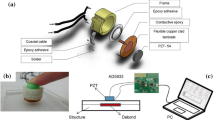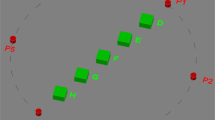Abstract
This paper describes a method to detect notch like damages in plates using piezoelectric transducers. The method does not use prior baseline data for damage detection. A single pair of piezoelectric wafer transducers made of Lead Zirconate Titanate (PZT) is attached back to back on the opposite sides of a plate and are used for simultaneous actuation and sensing. A notch, which is a sudden change in thickness of the plate, leads to mode conversion of Lamb waves. The mode converted wave component in the measured signal is then separated from the other Lamb wave mode components using polarization characteristics of the piezoelectric wafer transducers. The damage index is a function of the amplitude of this mode converted component of the signal. In real world situations, the damage index will not be exactly zero due to inaccuracy in transducer collocation and non-uniformity in their bonding conditions. Therefore, a (non-zero) threshold for the damage index needs to be established to avoid false alarms. True to the spirit of baseline-free damage detection, this threshold is computed from the signals acquired only from the current state of the structure. This is achieved by using redundancy in signal measurements. Since the method detects damages without having to rely on baseline data, environmental variations like temperature change do not affect its performance. Results from numerical simulations as well as experiments on aluminum specimens are provided to demonstrate the effectiveness of the method described above.
Similar content being viewed by others
References
Rose, J.L.: Ultrasonic Waves in Solid Media. Cambridge University Press, Cambridge (2004)
Boller, C., Chang, F., Fujino, Y.: Encyclopedia of Structural Health Monitoring. Wiley, New York (2009)
Staszewski, W., Boller, C., Tomlinson, G.R.: Health Monitoring of Aerospace Structures: Smart Sensor Technologies and Signal Processing. Wiley, New York (2004)
Rhian Green, E.: Acoustic emission in composite laminates. J. Nondestruct. Eval. 17, 117–127 (1998)
Donskoy, D.M., Sutin, A.M.: Vibro-acoustic modulation nondestructive evaluation technique. J. Intell. Mater. Syst. Struct. 9, 765 (1998)
Lamb, H.: On waves in an elastic plate. Proc. R. Soc. Lond. Ser. A, Contain. Pap. Math. Phys. Character 93, 114–128 (1917)
Auld, B.A.: Acoustic Fields and Waves in Solids. Krieger, Melbourne (1990). 2 Vol. Set
Viktorov, I.: Rayleigh and Lamb Waves: Physical Theory and Applications. Plenum, New York (1967)
Staszewski, W.J.: Structural health monitoring using guided ultrasonic waves. In: Advances in Smart Technologies in Structural Engineering, pp. 117–162 (2004)
Raghavan, A., Cesnik, C.E.: Review of guided-wave structural health monitoring. Shock Vib. Dig. 39, 91–114 (2007)
Dalton, R.P., Cawley, P., Lowe, M.J.S.: The potential of guided waves for monitoring large areas of metallic aircraft fuselage structure. J. Nondestruct. Eval. 20, 29–46 (2001)
Kundu, T.: Ultrasonic Nondestructive Evaluation: Engineering and Biological Material Characterization. CRC Press, Boca Raton (2003)
Su, Z., Ye, L., Lu, Y.: Guided Lamb waves for identification of damage in composite structures: a review. J. Sound Vib. 295, 753–780 (2006)
Sohn, H., Worden, K., Farrar, C.R.: Statistical damage classification under changing environmental and operational conditions. J. Intell. Mater. Syst. Struct. 13, 561 (2002)
Rizzo, P., di Scalea, F.L.: Wavelet-based unsupervised and supervised learning algorithms for ultrasonic structural monitoring of waveguides. In: Progress in Smart Materials and Structures, p. 227 (2006)
Kessler, S.S., Spearing, S.M., Soutis, C.: Damage detection in composite materials using Lamb wave methods. Smart Mater. Struct. 11, 269–278 (2002)
Younho, Cho: Estimation of ultrasonic guided wave mode conversion in a plate with thickness variation. IEEE Trans. Ultrason. Ferroelectr. Freq. Control 47, 591–603 (2000)
Kim, S.B., Sohn, H.: Instantaneous reference-free crack detection based on polarization characteristics of piezoelectric materials. Smart Mater. Struct. 16, 2375–2387 (2007)
Kim, S.B., Sohn, H.: Instantaneous crack detection using dual PZT transducers. In: Proceedings of SPIE, vol. 6935, pp. 09–12 (2008)
Cegla, F.B., Rohde, A., Veidt, M.: Analytical prediction and experimental measurement for mode conversion and scattering of plate waves at non-symmetric circular blind holes in isotropic plates. Wave Motion 45, 162–177 (2008)
Alleyne, D.N., Cawley, P.: The interaction of Lamb waves with defects. IEEE Trans. Ultrason. Ferroelectr. Freq. Control 39, 381–397 (1992)
Demma, A., Cawley, P., Lowe, M., Roosenbrand, A.G., Pavlakovic, B.: The reflection of guided waves from notches in pipes: a guide for interpreting corrosion measurements. NDT E Int. 37, 167–180 (2004)
Lowe, M.J.S., Alleyne, D.N., Cawley, P.: The mode conversion of a guided wave by a part-circumferential notch in a pipe. J. Appl. Mech. 65, 649 (1998)
Su, Z., Ye, L.: Selective generation of Lamb wave modes and their propagation characteristics in defective composite laminates. Proc. Inst. Mech. Eng. Part. L: J. Mater. Des. Appl. 218, 95–110 (2004)
Park, S., Lee, C., Sohn, H.: Reference-free crack detection using transfer impedances. J. Sound Vib. (2009)
Sazonov, E.S., Klinkhachorn, P., Halabe, U.B., GangaRao, H.V.: Non-baseline detection of small damages from changes in strain energy mode shapes. Nondestr. Test. Eval. 18, 91–107 (2002)
Anton, S.R., Inman, D.J., Park, G.: Reference-free damage detection using instantaneous baseline measurements. AIAA J. 47 (2009)
Hillis, A.J., Neild, S.A., Drinkwater, B.W., Wilcox, P.D.: Global crack detection using bispectral analysis. Proc. R. Soc., Math. Phys. Eng. Sci. 462, 1515 (2006)
Graff, K.F.: Wave Motion in Elastic Solids. Dover, New York (1991)
Cho, Y., Rose, J.L.: A boundary element solution for a mode conversion study on the edge reflection of Lamb waves. J. Acoust. Soc. Am. 99, 2097 (1996)
Achenbach, J.D.: Reciprocity in Elastodynamics. Cambridge University Press, Cambridge (2004)
Penrose, R.: A generalized inverse for matrices. In: Proc. Cambridge Philos. Soc., pp. 406–413 (1955)
Dosch, J.J., Inman, D.J., Garcia, E.: A self-sensing piezoelectric actuator for collocated control. J. Intell. Mater. Syst. Struct. 3, 166 (1992)
Hagood, N.W., Chung, W.H., Von Flotow, A.: Modelling of piezoelectric actuator dynamics for active structural control. J. Intell. Mater. Syst. Struct. 1, 327 (1990)
Lee, S.J., Sohn, H.: Active self-sensing scheme development for structural health monitoring. Smart Mater. Struct. 15, 1734–1746 (2006)
Giurgiutiu, V.: Structural Health Monitoring: With Piezoelectric Wafer Active Sensors. Academic Press, New York (2007)
Sohn, H.: Effects of environmental and operational variability on structural health monitoring. Philos. Trans. R. Soc., Math. Phys. Eng. Sci. 365, 539 (2007)
Park, G., Kabeya, K., Cudney, H.H., Inman, D.J.: Impedance-based structural health monitoring for temperature varying applications. JSME Int. J. Ser. A 42, 249–258 (1999)
Fritzen, C.P., Mengelkamp, G., Guemes, A.: Elimination of temperature effects on damage detection within a smart structure concept. In: Structural Health Monitoring 2003: From Diagnostics & Prognostics to Structural Health Management: Proceedings of the 4th International Workshop on Structural Health Monitoring, Stanford University, Stanford, CA, September 15–17, 2003, pp. 1530–1538 (2003)
Lu, Y., Michaels, J.E.: A methodology for structural health monitoring with diffuse ultrasonic waves in the presence of temperature variations. Ultrasonics 43, 717–731 (2005)
Croxford, A.J., Wilcox, P.D., Drinkwater, B.W., Konstantinidis, G.: Strategies for guided-wave structural health monitoring. Proc. R. Soc., Math. Phys. Eng. Sci. 463, 2961 (2007)
Author information
Authors and Affiliations
Corresponding author
Rights and permissions
About this article
Cite this article
Sohn, H., Dutta, D. & An, YK. Temperature Independent Damage Detection in Plates Using Redundant Signal Measurements. J Nondestruct Eval 30, 106–116 (2011). https://doi.org/10.1007/s10921-011-0096-6
Received:
Accepted:
Published:
Issue Date:
DOI: https://doi.org/10.1007/s10921-011-0096-6




